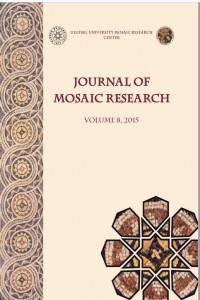The Ship Depicted on the North Colonnade of the Great Mosque at Damascus: A Nilotic Theme or the Representation of Paradise?
Abstract
This paper will bring for the first time an in-depth study of the ship depicted in the mosaic on the east pier of
the north colonnade of the courtyard in the Great Mosque at Damascus. The vessel inhabited by two men, one
sited on the prow and the second is the helmsman working the port steering-oar, synthesizes several topics:
1. The ship and the adjacent architecture in the Damascus mosaic evidence the continuity of Roman tradition
of maritime or Nilotic scenes depicted in Umayyad mosaics;
2. Suggestion for the symbolic representation of the Paradise referred in the Koran;
3. The depiction of human figures in early Islamic arts suggests the tolerance of the Umayyad regime
compared to the more restricted iconoclastic law in the Abbasid period and supported by the Hadith;
4. Preserved shipbuilding tradition of the Pharaonic Egyptian papyriform vessels and their diffusion as late
as the 8th century CE in the eastern Mediterranean.
We may suggest that the ship illustrated in the mosaic in the Great Mosque at Damascus belongs to the original
building period of the Mosque by al-Walid I (705-715 CE). The boats depicted within the Nilotic frame
surrounding the main mosaic carpet in the Church of St. Stephen at Umm al-Rasas in Jordan (718-756 CE)
are the latest examples of Nilotic theme decoration within a Christian Church built and functioning during
the Umayyad – Abbasid periods. The Damascus and al-Rasas mosaics both are related in subject decoration,
and their architectural content, within different religious edifices (church and mosque), and their illustrated
messages may suggest the same symbolism.
Keywords
Şam’daki Emeviye Camii Kuzey Sütun Dizisi Üzerinde Yer Alan Gemi Tasviri: Nil Nehrine Ait Bir Konu ya da Cennet Tasviri?
Abstract
Bu makalede, ilk kez Şam Emeviye Cami’nin avlusunun kuzey sütunları doğu cephesi üzerindeki mozaikte bulunan gemi tasviri derinlemesine incelenmiştir. Gemi üzerinde iki erkek betimi vardır. Bunlardan ilkinde erkek pruva üzerindeyken diğer erkek kürek çeken bir dümenci olarak gösterilmiştir.1. Şam mozaiklerindeki gemi ve onunla bitişik mimari betim, Emevi mozaiklerinde tasvir edilen ve Roma geleneği olan Nil Nehri ya da deniz sahnelerinin sürekliliğine bir delil teşkil eder. 2. Bu sahne, Kur’an’da geçen sembolik cennet tasvirini akla getirmektedir.3. Erken İslam sanatındaki insan figürleri, Hadis tarafından desteklenen ve Abbasi Dönemi’nde daha sınırlı ikonoklastik anlayışla karşılaştırıldığında daha hoşgörülü bir Emevi rejimini göstermektedir.4. Mısır papirüs çiçeği formundaki gemilerin yapım geleneği, Doğu Akdeniz’de en geç 8. yüzyıla kadar kullanıldığını göstermektedir.5. Şam Emeviye Camii mozaiklerindeki gemi tasvirinin, Cami’nin el-Velid tarafından yaptırılan orijinal yapı dönemine ait olduğu düşünülmektedir. Ürdün, Umm al-Rasas’taki Aziz Stephen Kilisesinde bulunan ana mozaiği çevreleyen Nil sahnesinde betimlenen gemi tasvirleri , Emevi-Abbasi döneminde kullanılan bir Hristiyan Kilisesi içinde Nil temalı son örneklerdir. Şam ve al-Rasas mozaiklerinin her ikisi de dekorasyon konusuyla ilgilidir ve onların mimari içerikleri, farklı dini yapıların içinde bulunmaları (kilise ve camii), ortaya koydukları mesajlar aynı sembolizme işaret eder
Keywords
Details
| Other ID | JA22DZ45KJ |
|---|---|
| Journal Section | Article |
| Authors | |
| Publication Date | December 1, 2015 |
| Published in Issue | Year 2015 Issue: 8 |


